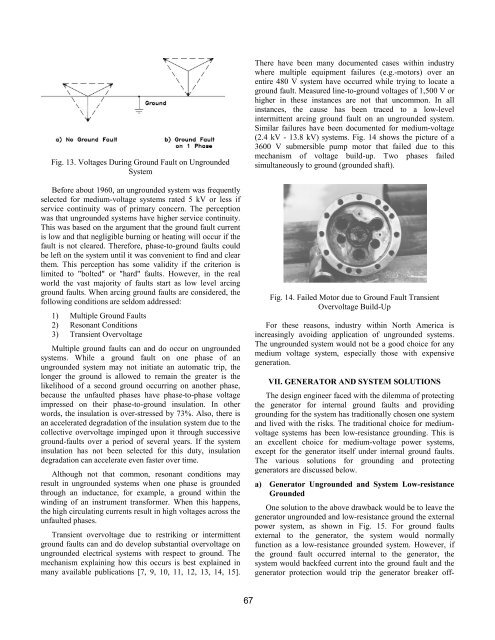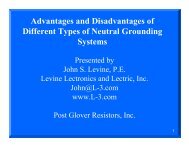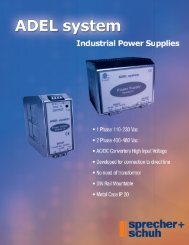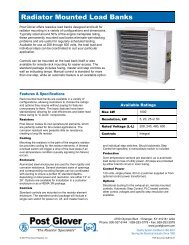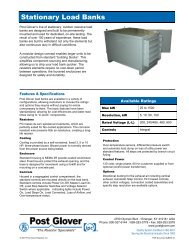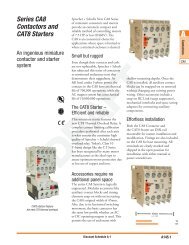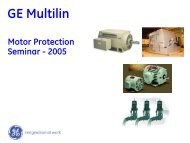IEEE Hybrid Grounding
IEEE Hybrid Grounding
IEEE Hybrid Grounding
Create successful ePaper yourself
Turn your PDF publications into a flip-book with our unique Google optimized e-Paper software.
Fig. 13. Voltages During Ground Fault on Ungrounded<br />
System<br />
Before about 1960, an ungrounded system was frequently<br />
selected for medium-voltage systems rated 5 kV or less if<br />
service continuity was of primary concern. The perception<br />
was that ungrounded systems have higher service continuity.<br />
This was based on the argument that the ground fault current<br />
is low and that negligible burning or heating will occur if the<br />
fault is not cleared. Therefore, phase-to-ground faults could<br />
be left on the system until it was convenient to find and clear<br />
them. This perception has some validity if the criterion is<br />
limited to "bolted" or "hard" faults. However, in the real<br />
world the vast majority of faults start as low level arcing<br />
ground faults. When arcing ground faults are considered, the<br />
following conditions are seldom addressed:<br />
1) Multiple Ground Faults<br />
2) Resonant Conditions<br />
3) Transient Overvoltage<br />
Multiple ground faults can and do occur on ungrounded<br />
systems. While a ground fault on one phase of an<br />
ungrounded system may not initiate an automatic trip, the<br />
longer the ground is allowed to remain the greater is the<br />
likelihood of a second ground occurring on another phase,<br />
because the unfaulted phases have phase-to-phase voltage<br />
impressed on their phase-to-ground insulation. In other<br />
words, the insulation is over-stressed by 73%. Also, there is<br />
an accelerated degradation of the insulation system due to the<br />
collective overvoltage impinged upon it through successive<br />
ground-faults over a period of several years. If the system<br />
insulation has not been selected for this duty, insulation<br />
degradation can accelerate even faster over time.<br />
Although not that common, resonant conditions may<br />
result in ungrounded systems when one phase is grounded<br />
through an inductance, for example, a ground within the<br />
winding of an instrument transformer. When this happens,<br />
the high circulating currents result in high voltages across the<br />
unfaulted phases.<br />
Transient overvoltage due to restriking or intermittent<br />
ground faults can and do develop substantial overvoltage on<br />
ungrounded electrical systems with respect to ground. The<br />
mechanism explaining how this occurs is best explained in<br />
many available publications [7, 9, 10, 11, 12, 13, 14, 15].<br />
There have been many documented cases within industry<br />
where multiple equipment failures (e.g.-motors) over an<br />
entire 480 V system have occurred while trying to locate a<br />
ground fault. Measured line-to-ground voltages of 1,500 V or<br />
higher in these instances are not that uncommon. In all<br />
instances, the cause has been traced to a low-level<br />
intermittent arcing ground fault on an ungrounded system.<br />
Similar failures have been documented for medium-voltage<br />
(2.4 kV - 13.8 kV) systems. Fig. 14 shows the picture of a<br />
3600 V submersible pump motor that failed due to this<br />
mechanism of voltage build-up. Two phases failed<br />
simultaneously to ground (grounded shaft).<br />
Fig. 14. Failed Motor due to Ground Fault Transient<br />
Overvoltage Build-Up<br />
For these reasons, industry within North America is<br />
increasingly avoiding application of ungrounded systems.<br />
The ungrounded system would not be a good choice for any<br />
medium voltage system, especially those with expensive<br />
generation.<br />
VII. GENERATOR AND SYSTEM SOLUTIONS<br />
The design engineer faced with the dilemma of protecting<br />
the generator for internal ground faults and providing<br />
grounding for the system has traditionally chosen one system<br />
and lived with the risks. The traditional choice for mediumvoltage<br />
systems has been low-resistance grounding. This is<br />
an excellent choice for medium-voltage power systems,<br />
except for the generator itself under internal ground faults.<br />
The various solutions for grounding and protecting<br />
generators are discussed below.<br />
a) Generator Ungrounded and System Low-resistance<br />
Grounded<br />
One solution to the above drawback would be to leave the<br />
generator ungrounded and low-resistance ground the external<br />
power system, as shown in Fig. 15. For ground faults<br />
external to the generator, the system would normally<br />
function as a low-resistance grounded system. However, if<br />
the ground fault occurred internal to the generator, the<br />
system would backfeed current into the ground fault and the<br />
generator protection would trip the generator breaker off-<br />
67


